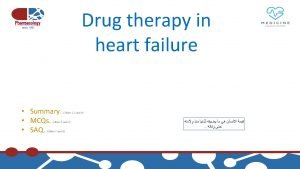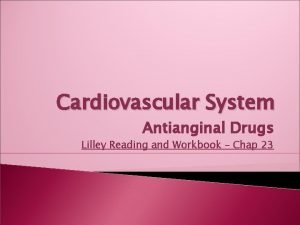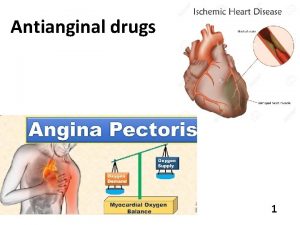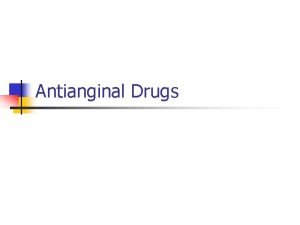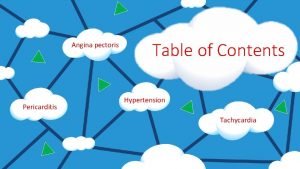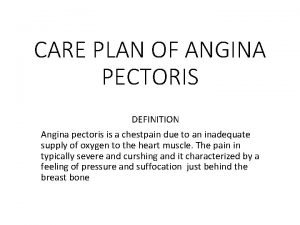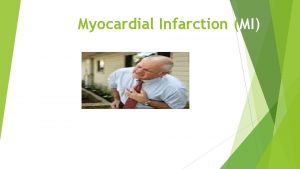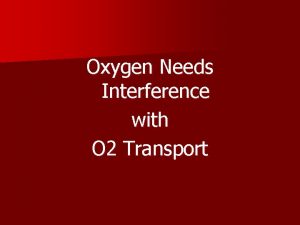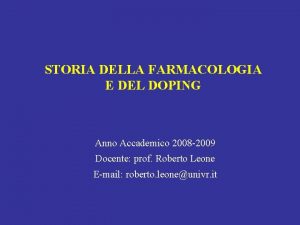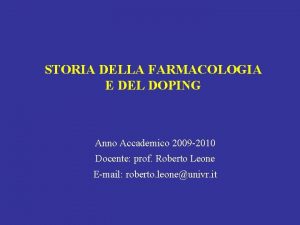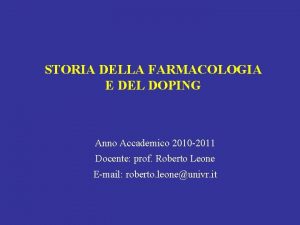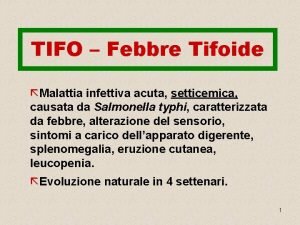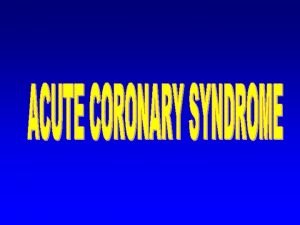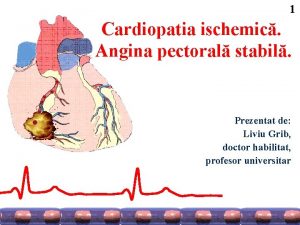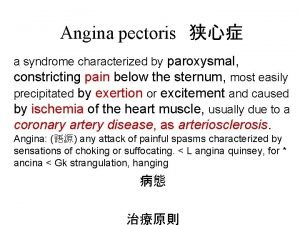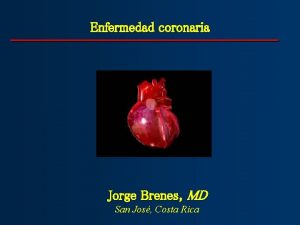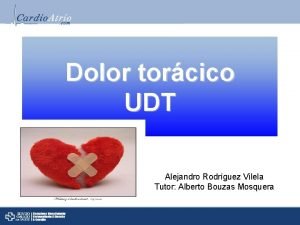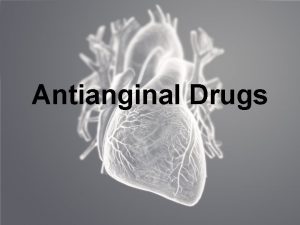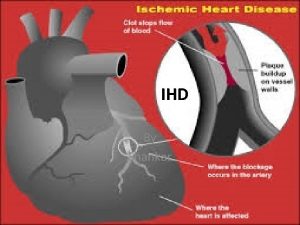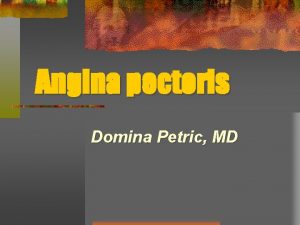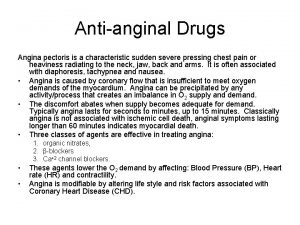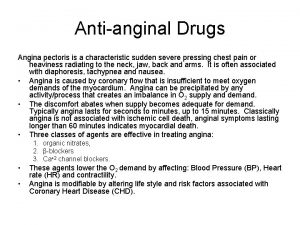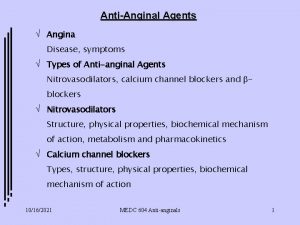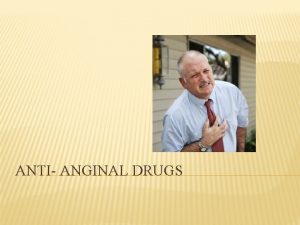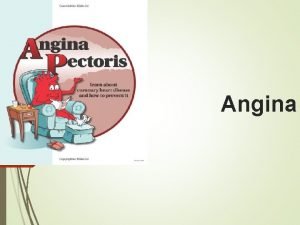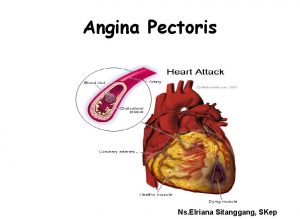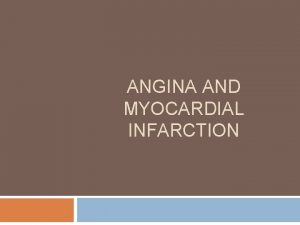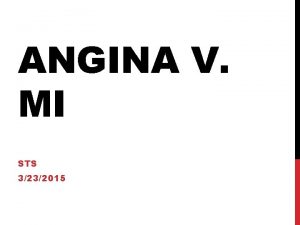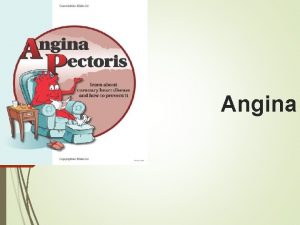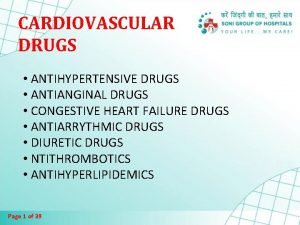Antianginal Drugs OVERVIEW n Angina pectoris is a


















- Slides: 18

Antianginal Drugs

OVERVIEW n Angina pectoris is a characteristic chest pain caused by coronary blood flow that is insufficient to meet the oxygen demands of the myocardium.

ORGANIC NITRATES n Organic nitrates are simple nitric and nitrous acid esters of alcohols. These compounds cause a rapid reduction in myocardial oxygen demand followed by rapid relief of symptoms. They are effective in stable and unstable angina, as well as Prinzmetal's or variant angina pectoris.

Nitroglycerin n Nitrates, beta-blockers, and calcium channel blockers are equally effective for relief of anginal symptoms. However, for prompt relief of an ongoing attack of angina precipitated by exercise or emotional stress, sublingual (or spray form) nitroglycerin is the drug of choice.

Mechanisms of action n nitroglycerin are thought to relax vascular smooth muscle by their intracellular conversion to nitrite ions and then to nitric oxide (NO), which in turn activates guanylate cyclase and increases the cells' cyclic GMP. Elevated c. GMP ultimately leads to dephosphorylation of the myosin light chain, resulting in vascular smooth muscle relaxation.

Effects on cardiovascular system n n First, it causes dilation of the large veins, resulting in pooling of blood in the veins. This diminishes preload (venous return to the heart), and reduces the work of the heart. Second, nitroglycerin dilates the coronary vasculature, providing increased blood supply to the heart muscle. Nitroglycerin causes a decrease in myocardial oxygen consumption because of decreased cardiac work.

Pharmacokinetics n n n The time to onset of action varies from one minute for nitroglycerin to more than one hour for isosorbide mononitrate. Significant first-pass metabolism of nitroglycerin occurs in the liver. either sublingually or via a transdermal

Adverse effects n The most common adverse effect of nitroglycerin, as well as the other nitrates, is headache. Thirty to sixty percent of patients receiving intermittent nitrate therapy with longacting agents develop headaches. High doses of organic nitrates can also cause postural hypotension, facial flushing, and tachycardia.

Tolerance n Tolerance to the actions of nitrates develops rapidly. It can be overcome by provision of a daily "nitrate-free interval" to restore sensitivity to the drug. This interval is typically 6 to 8 hours, usually at night because there is decreased demand on the heart at that time.

beta-ADRENERGIC BLOCKERS n beta-adrenergic blocking agents suppress the activation of the heart by blocking beta-receptors. They also reduce the work of the heart by decreasing cardiac output and causing a slight decrease in blood pressure. Propranolol is the prototype of this class of compounds.

n n The beta-blockers reduce the frequency and severity of angina attacks. These agents are particularly useful in the treatment of patients with myocardial infarction. The beta-blockers can be used with nitrates to increase exercise duration and tolerance. contraindicated in patients with diabetes, peripheral vascular disease, or chronic obstructive pulmonary disease.

CALCIUM CHANNEL BLOCKERS n The calcium channel blockers inhibit the entrance of calcium into cardiac and smooth muscle cells of the coronary and systemic arterial beds. All calcium channel blockers are therefore vasodilators that cause a decrease in smooth muscle tone and vascular resistance. At clinical doses, these agents affect primarily the resistance of vascular smooth muscle and the myocardium.


Nifedipine n Nifedipine functions mainly as an arteriolar vasodilator. This drug has minimal effect on cardiac conduction or heart rate. Nifedipine is administered orally and has a short half-life (about 4 hours) requiring multiple dosing. The vasodilation effect of nifedipine is useful in the treatment of variant angina caused by spontaneous coronary spasm.

side effects n Nifedipine can cause flushing, headache, hypotension, and peripheral edema as side effects of its vasodilation activity. The drug may cause reflex tachycardia if peripheral vasodilation is marked resulting in a substantial decrease in blood pressure.

Verapamil n Verapamil slows cardiac conduction directly and thus decreases heart rate and oxygen demand. Verapamil causes greater negative inotropic effects than does nifedipine, but it is a weaker vasodilator.

Diltiazem n Diltiazem has cardiovascular effects that are similar to those of verapamil. It reduces the heart rate, although to a lesser extent than verapamil, and also decreases blood pressure. In addi- tion, diltiazem can relieve coronary artery spasm and is therefore particularly useful in patients with variant angina. The incidence of adverse side effects is low. shows treatment of angina in patients with concomitant diseases.

contraindication n Verapamil is contraindicated in patients with preexisting depressed cardiac function or AV conduction abnormalities. It also causes constipation. Verapamil should be used with caution in digitalized patients, since it increases digoxin levels
 Na k atpase pump
Na k atpase pump Antianginal drugs
Antianginal drugs Variant angina
Variant angina Chronic coronary syndrome
Chronic coronary syndrome Nitroglycerin srdce
Nitroglycerin srdce Nitroglycerin srdce
Nitroglycerin srdce Nursing diagnosis of angina pectoris
Nursing diagnosis of angina pectoris Angina pathophysiology
Angina pathophysiology Lingsard
Lingsard Medici antiqui pectoris
Medici antiqui pectoris Angian pectoris
Angian pectoris Erectus farmacia galeno
Erectus farmacia galeno Medici antiqui pectoris
Medici antiqui pectoris Roseole tifose
Roseole tifose Braunwald classification of unstable angina
Braunwald classification of unstable angina Angina pectorală definiție
Angina pectorală definiție Angina
Angina Angina inestable
Angina inestable Probabilidad pretest angina
Probabilidad pretest angina
